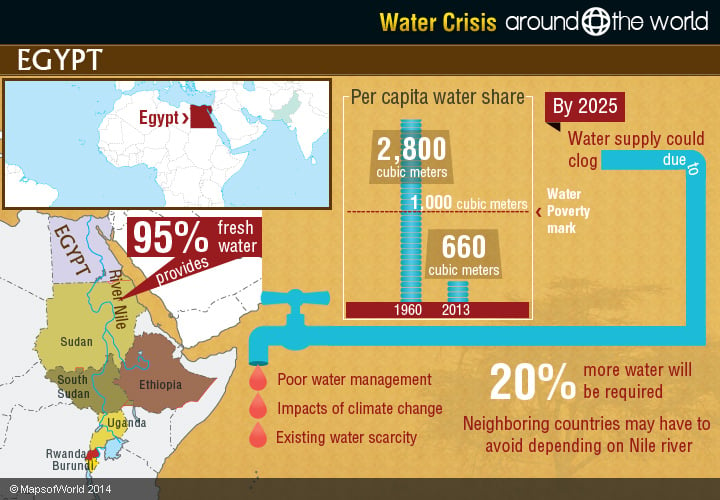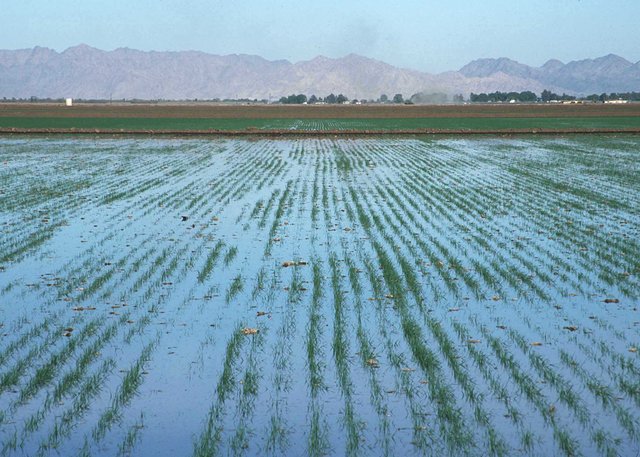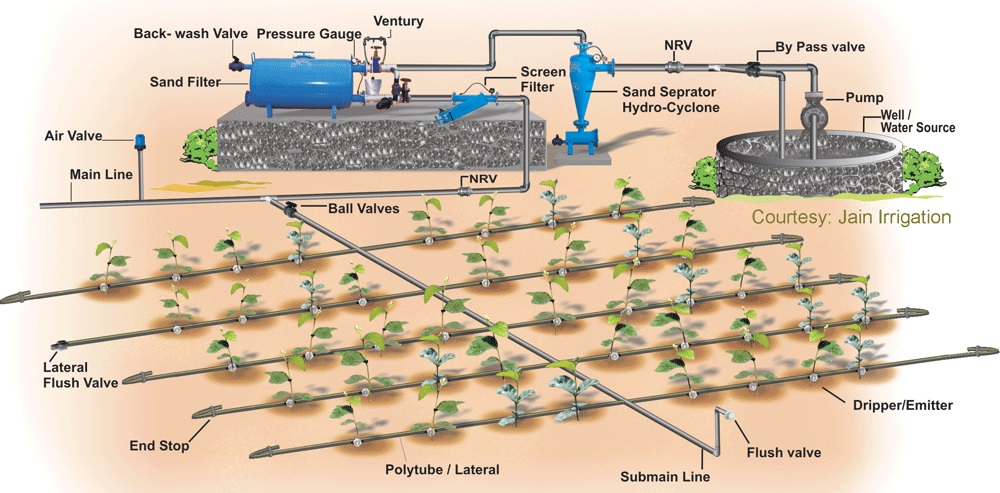(Dried up river bed near the mouth of the Nile River in Egypt)
As Egypt is becoming more and more modern, water is becoming more and more scarce, let alone clean. But why is this? What happened to the peoples ability to accesses clean drinking water? It wasn’t always like this, right? Right! In this weeks blog, we will be taking a look at the reasons why water is becoming a scarce resource in the Nile Basin, as well as look at solutions to help end the water crisis.
In any given year, most of Egypt is likely to see between 0 and 80 millimeters of rain. Despite its extremely dry climate and limited arable land (97 percent of which is unsuitable for cultivation), 86 million people live in Egypt. To accommodate for the dryness, Egypt pulls 55.5 billion cubic meters of water each year from the Nile River. The water that is pulled from the river comes water rich areas that are far upstream. Being forced to rely on water that originates hundreds of miles away, creates worries for the Egyptians. Countries that are further upstream, such as Tanzania and Uganda as well as eight other countries, get their water from the Nile as well, which leads Egyptians to worry about the potential pollutants that these countries may have dumped into the water. This means that to get a handle on the water crisis, Egypt has to consider their own usage of the limited resource, along with ten other countries, as well as make sure the water they are providing is clean.
In the Nile Basin is leading to a range of conflicts. Its not because there is not enough scientific information to go around, but rather for other reasons. Water stress has been on the rise in Nile Basin because of the growing population, current allocation practices, unchecked demand, and underinvestment in infrastructure.
(Rice Paddy in the Nile-Basin in Egypt.
Egypt uses over 65 billion cubic meters of water annually, while 200 billion cubic meters of water is lost from rain-fed crops due to evapotranspiration. Water productivity for crops, or “crop per drop,” is similarly low for most of the Nile Basin countries, with crop yields in the range of 1 ton per hectare (about 2.47 acres). This compares to 2.5 to 3 tons per hectare in India and over 4 in the United States for grain crops. These figures show that there is a significant opportunity here to improve crop water productivity and yield in the Nile Basin.
Access to water is not just a function of supply. Key roles are played by the price of water and the ability to distribute water to those who need it. If the price is too high, or there is a lack of water distribution infrastructure, then even if water is present, it is effectively not accessible. Therefore access, not supply, is typically at the heart of the water crises.
When water is a limited resource, conflicts immediately emerge over how it should be allocated. Arguments about whose rights needs are greater lead to tussles over sovereignty and threats of violence. The Nile Basin is no different. Most debates about water among the countries of the Nile Basin are centered around the allocation of the 84 billion cubic meters of water that flow, on average, every year down the river. Egypt wants to preserve its historic rights to the Nile waters on the basis of 1929 and 1959 agreements that gave 55.5 billion cubic meters of water per year to Egypt. This agreement also entitles Egypt to veto any project that takes place upstream that they believe will negatively affect their ability to gather clean water, such as when Egypt denied Ethiopia’s request to build a dam on the Nile. But these agreements all preceded the independence of many Nile Basin countries such as the Democratic Republic of the Congo, Rwanda, and Kenya. Allocation of the Nile has been a controversial topic for decades. Recently this controversy became more heated as the other countries as the other countries deemed the 1959 allocation agreement invalid.
(Diagram showing how water can be recycled in a persons home)
In order to reduce hostilities between nations and improve water efficiency in Egypt. One solution may be technological: What if more water could be “created”? The adoption of water conservation and recycling methods combined with improved water use efficiency could be part of the solution for expanding the availability and efficient use of water. By treating water rather then disposing of it, Egypt can expect to greatly reduce the amount of water that they need to pull out of the Nile in order to keep the country hydrated.
(Diagram of a “Drip-feed” system)
At the moment, the largest “user” of water is evapotranspiration. When Egyptian farmers water their crops, much of the water is evaporated and lost to the air rather then being absorbed by the crops. This causes farmers to be very inefficient in their water use when watering crops. Improving agricultural efficiency of water use could include adopting more modern “drip-feed” irrigation techniques, selecting more drought tolerant crops and livestock, and capturing and reusing the water runoff from irrigated fields. There is also a potential role for desalination, wastewater treatment and reuse, and more sustainable energy sources that power the systems that provide clean water.
Furthermore, possible constructive moves include encouraging the political leaders in Egypt to renounce any unilateral action; reconvening informally to talk about interiom steps or possible measures to “create more water”. Egypt has to create joint problem solving efforts to monitor how experimental efforts are working and learn other Basin-level efforts to more efficiently use water, as well as reduce tensions between nations.
Sources
Farajallah, Nadim. “The Middle East and North Africa’s Water Resources in a Changing Climate: Heinrich Böll Stiftung.” Heinrich-Böll-Stiftung, 31 Oct. 2012, www.boell.de/en/2012/10/31/middle-east-and-north-africas-water-resources-changing-climate.
Grundy, Kenneth. “South Africa: Domestic Crisis and Global Challenge.” Choice Reviews Online, vol. 29, no. 07, 1992, doi:10.5860/choice.29-4124.
Islam, Shafiqul, and Lawrence Susskind. “Understanding the Water Crisis in Africa and the Middle East: How Can Science Inform Policy and Practice?” Bulletin of the Atomic Scientists, vol. 71, no. 2, 2015, pp. 39–49., doi:10.1177/0096340215571906.





This post is extremely in-depth (pun intended) and a great analysis of the often-overlooked problems facing Egypt, and indirectly the other nations which depend on the Nile for clean water. This post is very informative as well, maintaining a tone of education as well as tying in a call to action.
The graphics you provided in this post were really striking. It’s interesting how we’re beginning to notice human impacts and how our over consumption of natural resources is one of the biggest reasons why we’re approaching trouble, whether that be from the Nile River or the Amazon Rain Forest.
I love your photos and graphics they bring so much strength to the post in my opinion.
I do believe that the biggest war we are ever going to see will be over freshwater because you need it way more than anything else in the world. You can survive without your iPhones and computers, you can even survive a few days without food, but you can barely survive three days without water. its a necessity of life.
I am in an ancient Egypt class right now where we were talking about the Nile river and the devastating effects it can have when it does not produce enough water for people. I found it really interesting how you talked about the conflict that can arise from water scarcity. Has there been any progress made in Egypt in terms of using new technology to save water?
I didn’t have any idea that Egypt/the Nile River was such a present issue for water. I think it’s interesting that they’re currently relying on 60 or 90 year old contracts to continue to claim their rights to the water and prevent others from gaining access. The process to treat and recycle water definitely seems like a good place to start for this situation!